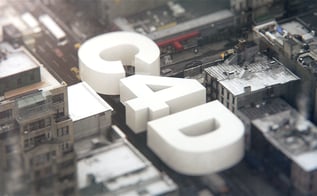Camera Mapping with the camera calibrator
Important notice for English members
This tutorial video has been translated into English with a voice-over, but the software interface remains in French.
Information
Contrary to what’s mentioned in the tutorial, the project file is not available for download. You’ll need to reproduce the techniques shown in this tutorial using your own photos.
Learn how to do camera mapping on a photo using the Camera Calibrator in Cinema 4D R14 Studio, and integrate typography into a photo-realistic urban scene.

Through this Cinema 4D and After Effects video tutorial, we’ll learn how to create an animation within a photo-realistic scene using the camera mapping technique.
We’ll then add a miniature effect called tilt-shift using the Lens Blur effect in After Effects. Finally, we’ll see how to export 3D coordinates from Cinema 4D to AE in order to create volumetric effects that perfectly match the 3D animation.
Discovering the Camera Calibrator in R14
The new tools introduced in Cinema 4D R14 make it very easy to create scenes using the camera mapping technique.
Thanks to the Camera Calibrator tool, it only takes a few well-placed reference points to recreate the camera’s position from a photo shoot. Once this position is obtained, we can use the camera to project the image onto 3D objects, thereby recreating the photo’s volumes.
The same applies to recent versions of After Effects (CS5 and above), which include a new tool for recreating scene depth of field using a Z-depth pass. We’ll learn how to repurpose this tool to achieve a tilt-shift effect.
- Learn how to use the Cinema 4D R14 Camera Calibrator tool to extract a camera position and texture.
- Easily model objects to project an image via camera mapping.
- Learn how to work around issues that occur when animating a camera within a camera-mapped scene.
- Export 3D coordinates from Cinema 4D to After Effects and create masks for compositing.
- Create a tilt-shift effect using the Lens Blur tool in After Effects.
- Create steam effects using the Particular plugin.
- Use 3D coordinates from Cinema 4D within After Effects.
Download the photo from iStockphoto
Thanks to a partnership with iStockphoto, you’ll soon be able to download the photo used in this tutorial for free, provided you sign up or already have an account with them.
Please check back in the coming days to get the download link.
About the author

François-Côme du Boistesselin is the General Manager and motion designer at Unit Motion Design, contributing to high-profile CG, VFX, and cinematic motion projects.